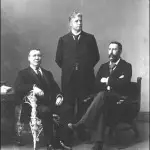
The Commonwealth of Australia Constitution contains a preamble followed by eight chapters, which themselves contain a total of 128 sections. The first eight sections are concerned with federation and legal requirements for establishing the Commonwealth; they have little practical use for law-making today. The remaining sections, however, play a major role in determining law-making powers. The Commonwealth Constitution provides the Federal government with significant law-making capacity – however it also places noticeable limits and constraints on its legislative power. The law-making powers of the States are also outlined to a considerable degree. So too is executive power, the function and powers of the High Court and the means by which the Constitution can be altered.
Chapter One: Parliament. The largest and arguably most important chapter in the Constitution, Chapter One defines the structure and composition of Federal parliament. Amongst its sections are instructions on how parliamentarians should be chosen; the numbers of representatives in each House of Parliament; how parliament should operate as an administrative and law-making body; the powers of the parliament; the composition of the Senate and the House of Representatives and the legislative relationship between these two Houses.
Chapter Two: Executive Government. This chapter defines the executive government and stipulates where executive power lies, though more in theory than in practice. The offices, roles and powers of the Governor-General, the Federal Executive Council and ministers of the Crown are all outlined here. It is where you will find the Governor-General’s reserve powers. You won’t find mention of the Prime Minister, whose office exists by convention rather than by constitutional dictate.
Chapter Three: Judiciary. In this chapter, the High Court is established as the court of federal judicial power. The parliament may create other federal courts as it sees fit, and they shall draw their judicial and law-making power from this particular chapter. Parliament may determine the number of judges necessary, oversee their appointment and decide their retirement age.
Chapter Four: Finance and trade. Regulations for the financial dealings, appropriations and expenditure of the Commonwealth are set out in this chapter. It allows parliament to pass laws to raise revenue, to regulate trade and commerce, and to make grants to the States as it sees fit.
Chapter Five: States. This chapter defines the powers of the States in relation to the Federal government. The states are prohibited from certain actions, such as the raising of a defence force. The existing powers of the States are preserved, unless they are transferred to the Federal government within the text of the Constitution, or unless individual States surrender them to the Commonwealth voluntarily.
Chapter Six: New States. Here instructions and guidelines are provided for the admission of new states, as well as the administration of territories.
Chapter Seven: Miscellaneous. This chapter contained only three clauses. One provided instructions for the location of a future national capital; another discounted Aboriginal people from population counting or calculation (a section that was repealed after a 1967 referendum).
Chapter Eight: Changing the Constitution. One long section in this chapter outlines the process that needs to be completed for amendment of the Constitution.
© lawgovpol.com 2018. Content on this page may not be republished or distributed without permission. For more information please refer to our Terms of Use.
